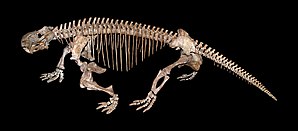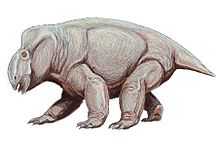Dicynodontia
| Dicynodontia | ||||||||||||
|---|---|---|---|---|---|---|---|---|---|---|---|---|

Tetragonias in the State Museum for Natural History Karlsruhe . |
||||||||||||
| Temporal occurrence | ||||||||||||
| Capitanium ( Middle Perm ) to Albium ( Lower Cretaceous ) | ||||||||||||
| 265 to 99.6 million years | ||||||||||||
| Locations | ||||||||||||
|
||||||||||||
| Systematics | ||||||||||||
|
||||||||||||
| Scientific name | ||||||||||||
| Dicynodontia | ||||||||||||
| Owen , 1859 |
The Dicynodontia (Greek: "two dog teeth") were herbivorous synapsids that had their heyday from the Middle Permian to the Lower Jurassic . On the Australian continent , they survived to the Lower Cretaceous.
Features and history of development
Representatives of the Dicynodontia can be found on many continents, since in their time the land masses still formed the supercontinent Pangea. Their trunk was barrel-shaped because the animals, as herbivores, needed a relatively long digestive tract. Unlike most reptiles, their tail was very short. Her toothless mouth ended in a horned beak; on its sides the dicynodontians had two tusks ("dogs" - read: canines, hence the name), which could have been used for digging in many species.
The early Dicynodontier ( Eodicynodon , Diictodon ) were still relatively small with little more than 30 cm in length and probably lived in underground tunnels, which offered them protection from natural enemies such as the Gorgonopsiden . Only a few genera of the dicynodontic animals survived the great wave of extinction at the end of the Permian, which wiped out over 90% of all species living on earth, including such important ones as the trilobites in the sea and the pareiasaurs on land.
In the Triassic period, some groups of dicynodontics went through adaptive radiation again and species with significantly larger bodies developed. Of these later dicynodonts, the Lystrosaurus , which presumably lived in large herds, was still one of the smallest. Much larger, however, were Kannemeyeria with a length of about 3 meters and Placerias , a hippopotamus-like dicynodont animal with a length of about 3.5 meters and a weight of about a ton. Lystrosaurus was the dominant genus of herbivorous vertebrates in the early Triassic. The late form Lisowicia from the Upper Triassic reached a length of 4.5 meters, a height of 2.6 meters and a weight of an estimated nine tons compared to its predecessors. This makes it one of the largest land vertebrates of that time, which existed alongside the dinosaurs.
In contrast to earlier representatives of this group, they had to beware of the archosaurs such as Proterosuchus or Postosuchus, which were widespread in the Triassic . Occasionally even the relatively small dinosaurs like Coelophysis and cynodontics like Cynognathus could be dangerous to them, because it is assumed that they hunted in packs. However, as herd animals, they will not have been easy prey. Shortly after the beginning of the Jurassic, however, they gradually became extinct, at a time when herbivorous cynodontics and especially herbivorous dinosaurs were gaining in importance.
Systematics
-
Dicynodontia
- Eodicynodon
- Endothiodone
- Kingoria
- Diictodontoidea
- Pristerodontia
literature
- Thomas S. Kemp: The Origin & Evolution of Mammals. Oxford University Press, Oxford 2005. ISBN 0-19-850761-5 .
- Michael J. Benton : Paleontology of the vertebrates . Publishing house Dr. Friedrich Arrow. Munich, 2007 ISBN 3-89937-072-4
- Robert L. Carroll: Vertebrate Paleontology and Evolution , WH Freeman & Co., New York 1988. ISBN 0-7167-1822-7
Individual evidence
- ^ A b Tony Thulborn, Susan Turner: The last dicynodont: an Australian Cretaceous relict. In: Proceedings of the Royal Society of London 270 (1518), May 7, 2003, pp. 985-993, doi : 10.1098 / rspb.2002.2296
- ^ T Sulej, Niedzwiedzki G: An elephant-sized Late Triassic synapsid with erect limbs . In: Science . 363, 2019, pp. 78-80. PMID 30467179 .
Web links
- The Paleobiology Database Dicynodontia
- Palaeos Dicynodontia



